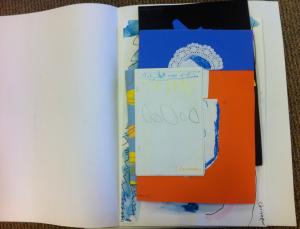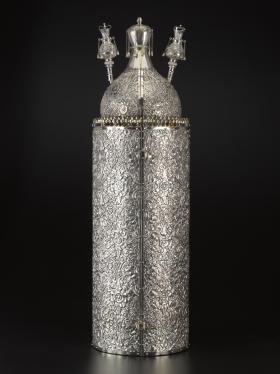Prep
- Fold tag board in half (on long side).
- Staple folded tag board together on the two short sides, leaving the unfolded, large side open.
Set Up
- Place one folded tag board at each seat for the students.
- Have a tub of nontoxic markers ready at each table.
Introduction/ Warm-Up
- Talk with students about how they are all artists and that artists need a place to keep their work safe.
- Show sample portfolio with artwork inside. Tell students that the folder is called a portfolio. Ask them to say the word with you—portfolio.
- Transition to a conversation about the Torah Case and show them the image. Ask students if they think it is art and why or why not. Ask them to describe the detail they see on the case. Explain that the case holds and protects something very special—the Torah (a book).
- Explain that the case is very big. Have a student volunteer stand up and explain that the Torah Case is about as tall as he or she is.
- Point out how the Torah Case opens and closes to protect the Torah inside. Discuss how the book inside is not made from pages that turn like books the students use but was written on paper that is rolled up (hold up a roll of paper towels as a visual).
- Ask students to think of things that are special to them. Share teacher examples to prompt conversation. Quickly have each student share one or two special things (a pet, a place, a family member). Discuss ways we keep these special things safe. Provide examples, such as book covers, storage containers, drawers.
- Tell students they will be making a portfolio to protect special artwork they create in class.
Focus Activity Procedure
- Show students folded poster board, and tell them that this is going to become their art portfolio.
- Ask students to think of things that are special to them. Have the students take turns sharing a few of these things with the class.
- Tell students that they will draw some of these special things on their portfolios. Reassure students that they don’t have to draw pictures that look like the real object, person, or place. Their drawings will be special however they turn out. Encourage students to fill up the entire area of white poster board with special drawings.
- Excuse students to their tables to work. Circulate around the room and talk with students about what they are drawing. Ask open-ended questions about the choices students are making.
- When students are finished, they should put markers in the container and move to a designated quiet activity until the rest of the class is done.
Closing
- Gather class for closing routine.
- Ask students to share the name of a special folder to hold art and keep it safe —a portfolio. Ask students to share something they added to their portfolio to make it special.
- Ask students to look for art all around them at home and at school!

- Talk with class about their portfolios and what they would like to place in them to assess their understanding of the concept that a portfolio keeps artwork safe.
- While students are working, assess if their drawings represent people, places, or objects that are important to them.
portfolio
draw
case
Torah
white tag board
non toxic markers, separated into plastic tubs
sample of an art portfolio with artwork inside
roll of paper towels
sample objects of things that are important to the teacher to use as examples (seashells, a favorite book, a photo of a pet).
Extension Activities for Teachers
- Make a scroll “book” add drawings/ writing/ tell a story.
Extension Activities for Families
- Make folded cards for family members and friends. Draw a picture on them to decorate. Help your child write notes to loved ones.
- Talk about family traditions and how special items in the home are protected.
- Talk about how your child’s artwork can be displayed and protected at home. Is there a special place where artwork is kept?



Among the Jewish communities in the Islamic lands, it was often customary to enshrine the Torah scroll in a hinged case made of wood and often sheathed in copper or precious metals. The scroll is wound on two rollers within the case and is never removed. During readings the open case stands upright on a table.
This important case is one of a small group of Jewish ritual objects made by Chinese artisans for the Baghdadi Jewish communities of India. The Baghdadi Jews arrived on the Indian subcontinent from Syria, Iraq, and Persia in the late eighteenth and early nineteenth centuries. Settling primarily in port cities, they were renowned traders, merchants and financiers with commercial interests stretching from the Mediterranean to the Pacific. This case was once one of the treasures of the Magen David Synagogue, the preeminent Baghdadi synagogue in Bombay (Mumbai). According to one of the Hebrew inscriptions, it was dedicated by a rabbi as a memorial to his wife.
Religious objects tend to be conservative in design, and the Chinese artisans respected the domed cylindrical form of a traditional Iraqi Torah case. However, the surface decoration—an opulent pattern of flowers and leaves—is unmistakably East Asian in its delicate naturalism. Symbolically, the case encloses the sacred scroll in a silvery garden, alluding to the beauty of life and perhaps of Eden. The ornamental finials are capped by crowns reminiscent of the British crown, a reminder perhaps of the privileged position of the Baghdadi Jews under the Raj.


